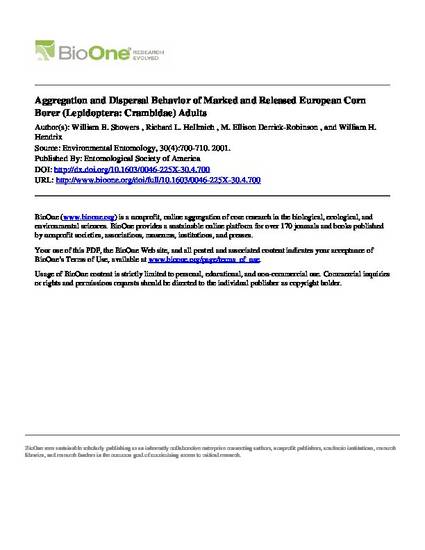
To observe the aggregation and dispersal behavior of adult European corn borer, Ostrinia nubilalis (Hu¨ bner), males in search of mates, two populations were marked, each with a different dye. One population was continuously reared in the laboratory (.5 yr) and the other was collected annually from the Þeld. From 1986 to 1988, marked adults were released in two release sets per year, with three to Þve releases per release set, coinciding with the spring and summer ßights of European corn borer in central Iowa. Traps for recapture contained lures baited with 40 mg of synthetic 97:3 Z:E-11-tetradecenyl acetate. Traplines extended from 200 m to 48 km. Each trap was assigned a compass direction. Males from the laboratory-reared population dispersed similarly to males just 1 generation from the wild. European corn borer males and females dispersed 23Ð49 km and some were recovered 14 km from the release site within 100 min after release. Sampling of aggregation sites demonstrated that on the nights of release, many adults aggregated in adjacent dense vegetation and did not disperse until the following night. Upon dispersal, these adults seemingly moved many meters or kilometers before settling again. Recapture of marked adults at 200 m might have been inßuenced by open landscapes (short, vegetative-growth corn). Recapture at 800 m or beyond, however, was unaffected by open landscapes, and in 1988 a greater proportion of marked males was recaptured while the landscape was closed. (tall, mature-growth corn). In 1987, during the Þrst ßight of European corn borer, displacement to 800 m was southeasterly, south, or west, but during Þrst ßights in 1986 and 1988, displacement to 800mwas predominately northeasterly. During the second ßight in midsummer, displacement to 800 m for all 3 yr of the study also was northeasterly. Recapture results from 1986 suggest that male movement.800mis common. During the Þrst release set (early summer), 37% of the males recaptured ßew 800 m or more and 8% ßew 3.2kmor more. During the second release set (late summer), 51% of the males recaptured ßew 800m or more and 11% ßew 3.2 km or more. The recommendation for placement of nontransgenic corn (Zea mays L.) as refuge in the Corn Belt is a half mile or closer to Bacillus thuringiensis Berliner (Bt)-corn if the refuge corn is not sprayed and a quarter mile or closer when the refuge corn is sprayed. Based on the dispersal results from this study, at least in Iowa, a half-mile proximity recommendation should be robust. Studies still should be conducted in other regions, especially where corn is commonly irrigated, to determine whether European corn borer adult movement patterns are similar.
Available at: http://works.bepress.com/richard_hellmich/45/

This article is from Environmental Entomology; 30 (2001); 700-710; doi: 10.1603/0046-225X-30.4.700